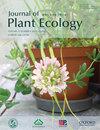Functional and phylogenetic similarities of co-occurring invaders affect the growth of an invasive forb
IF 3.9
2区 环境科学与生态学
Q2 ECOLOGY
引用次数: 0
Abstract
Expansion of global trade and acceleration of climate change dramatically promote plant invasions. As a result, a large number of habitats harbor multiple invasive plant species. However, patterns of invasive interactions and the drivers mediating their interactions remain unclear. In this greenhouse, potted plant study, we tested the impacts of 18 invasive plant species on the growth of target invader Erigeron canadensis which is dominant in central China. Neighboring invasive species belong to three functional groups (grass, forb and legume) and have different levels of relatedness to E. canadensis. Erigeron canadensis’ growth strongly depended on the identity of neighboring invaders. Some neighboring invasive species suppressed growth of E. canadensis, others had no effect, while some promoted growth of E. canadensis. Through analyses of functional and phylogenetic similarities between the target species and neighboring invaders, we showed that two factors probably play roles in determining the relative responses of E. canadensis. Generally, E. canadensis responded negatively to invasive grasses and forbs, while responded positively to invasive legumes. Furthermore, the negative responses to neighboring invasive grasses and forbs increased with increasing phylogenetic distance between the neighbors and E. canadensis. In contrast, the positive responses to invasive legumes did not depend on phylogenetic distance from E. canadensis. Our results suggest that successful invasion of E. canadensis probably depends on the identity of co-occurring invasive plant species. Interactions between E. canadensis and other invasive species should help managers select management priorities.共存入侵者的功能和系统发育相似性影响入侵性forb的生长
全球贸易的扩大和气候变化的加速极大地促进了植物入侵。因此,大量的栖息地孕育着多种入侵植物。然而,侵入性相互作用的模式以及介导其相互作用的驱动因素仍不清楚。在这项温室盆栽研究中,我们测试了18种入侵植物对华中地区占主导地位的目标入侵者加拿大飞蓬生长的影响。邻近入侵物种分为三个功能类群(草、杂类和豆类),与加拿大E.canadensis有不同程度的亲缘关系。加拿大飞蓬的生长在很大程度上取决于邻近入侵者的身份。一些邻近的入侵物种抑制了加拿大E.canadensis的生长,另一些则没有影响,而一些则促进了加拿大E.can的生长。通过分析目标物种与邻近入侵者之间的功能和系统发育相似性,我们表明两个因素可能在决定加拿大E.canadensis的相对反应中发挥作用。一般来说,加拿大E.canadensis对入侵草和杂类植物反应消极,而对入侵豆类植物反应积极。此外,对邻近入侵草和杂类的负面反应随着邻居与加拿大E.canadensis之间系统发育距离的增加而增加。相反,对入侵豆类的阳性反应并不取决于与加拿大E.canadensis的系统发育距离。我们的研究结果表明,加拿大E.canadensis的成功入侵可能取决于共存入侵植物物种的身份。加拿大E.canadensis和其他入侵物种之间的相互作用应该有助于管理者选择管理重点。
本文章由计算机程序翻译,如有差异,请以英文原文为准。
求助全文
约1分钟内获得全文
求助全文
来源期刊

Journal of Plant Ecology
生物-植物科学
CiteScore
4.60
自引率
18.50%
发文量
134
审稿时长
3 months
期刊介绍:
Journal of Plant Ecology (JPE) serves as an important medium for ecologists to present research findings and discuss challenging issues in the broad field of plants and their interactions with biotic and abiotic environment. The JPE will cover all aspects of plant ecology, including plant ecophysiology, population ecology, community ecology, ecosystem ecology and landscape ecology as well as conservation ecology, evolutionary ecology, and theoretical ecology.
 求助内容:
求助内容: 应助结果提醒方式:
应助结果提醒方式:


